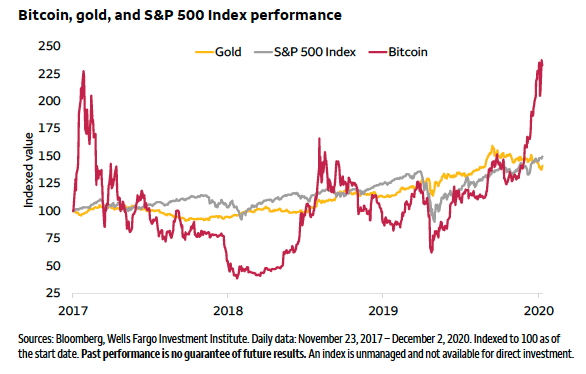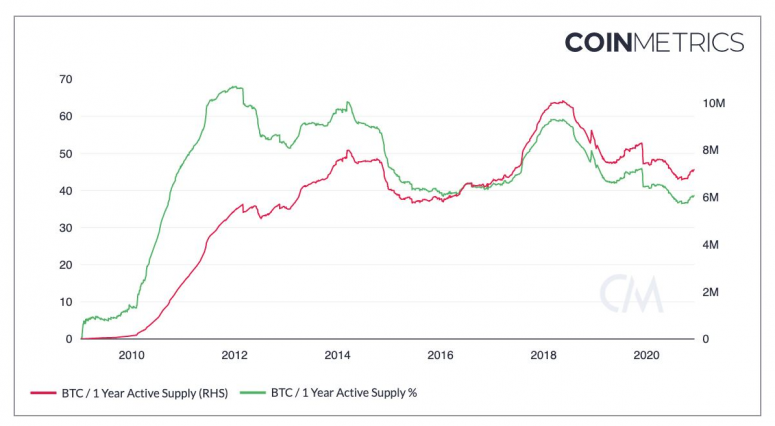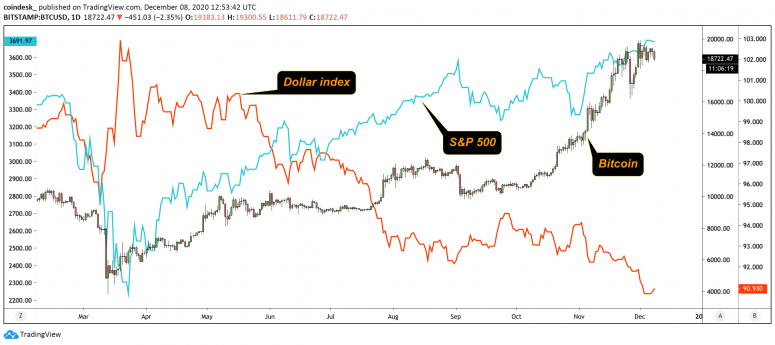Bitcoin was lower for a second day, dropping below $19,000 after bulls failed to push prices past the psychological $20,000 threshold.
“The overly confident market has been dampened,” the Norwegian crypto-market analysis firm Arcane Research wrote Tuesday in a report.
In traditional markets, European shares slid, led by travel-related companies, and U.S. stock futures pointed to a lower open as investors worried over the impact of rising coronavirus case numbers. The British pound weakened for a third day as optimism over a Brexit breakthrough faded, according to Bloomberg News. Gold was little changed at $1,863 an ounce.
Market moves
One theme comes up repeatedly in conversations with crypto insiders: just how fast the industry is moving. Even jaded pros are sometimes astonished (and annoyed) at how much new information they have to process each day.
Contrast that dynamic with the pace of progress in the U.S. stock market, where lately economic stimulus seems to be the only real thread in the news. There are reports of proposed stimulus bills from Congress, speculation over who might benefit most from stimulus and analysis on whether the stimulus is already priced in. Even last week’s disappointing report on U.S. jobs growth served to drive up stock prices, based on the topsy-turvy logic the prospects for more economic stimulus had increased.
Bitcoin prices have stagnated around $19,000 since surging last week to a new all-time high, yet the industry developments show no signs of slowing. Monday alone brought news of the cryptocurrency exchange Bittrex looking to list tokenized versions of stocks like Apple, Amazon and Tesla and an announcement by the digital-asset fund Arca of new custodial support for a tokenized U.S. Treasury bond fund. On the regulatory front, G7 finance ministers during a closed-door virtual session reportedly discussed the need to implement new rules for digital currencies, perhaps looking to slow things down.
There has certainly been no slackening in the pace of newcomers from traditional finance nudging into the crypto space or simply commenting on the bitcoin craze.
On Monday, a unit of Wells Fargo, the giant (and, at least for the past several years, beleaguered) U.S. bank, published a seven-page report devoting a full page to prices.
“Cryptocurrency investing is a bit like living in the early days of the 1850s gold rush,” according to the report from the Wells Fargo Investment Institute. “As we roll into 2021, we’ll be discussing the digital-asset space more – its upside and downside.”
That’s an explicit indication that even more attention is coming the way of cryptocurrencies, not less, as the calendar year rolls over.

But it turns out that bitcoin itself isn’t moving particularly quickly, at least by the historical standards of the underlying blockchain network. And that might be a bullish indicator.
On Monday, First Mover dug into one cryptocurrency fund’s analysis of whether bitcoin has climbed too far, too fast, or if the rally is just getting going. (ICYMI: Projected growth in the blockchain network suggests a whether bitcoin has climbed too far, too fast, as valued under Metcalfe’s Law.)
Another firm, Coin Metrics, which specializes in blockchain data analysis, noted in a recent report that it tracks a measure known as “1-year active supply.” This is the proportion of total bitcoin supply transferred over the blockchain network over the past year.
“As BTC price rises, an increasing amount of dormant supply typically starts to become active as long-term holders sell or move their BTC,” Coin Metrics wrote, using the trading symbol for bitcoin. “Conversely, when BTC price is low for extended periods of time, 1-year active supply percent tends to drop as investors hold through crypto winters.”
Recently, the 1-year active supply percentage appears to have ticked up slightly, climbing from a low of 36.5% reached in early September. But the metric is still below 40%, and well off the 59% reached in early 2018, in the wake of bitcoin’s last bull run to nearly $20,000.
That might indicate there’s little appetite among bitcoin holders to take profits just yet. And it means that newcomers might have to pay up if they want to get in.
– Bradley Keoun

Bitcoin watch

Bitcoin is on the offer this Thursday morning alongside losses in the European stock markets.
The top cryptocurrency is trading well below $19,000, representing more than a 2% drop on the day, having faced multiple rejections near $19,400 in the past 48 hours.
Risk sentiment has soured with fading prospects of the U.K.-European Union trade deal; major European indices are down 0.3% and futures tied to the S&P 500 are pointing to a negative open.
Bitcoin’s repeated failure to keep gains above $19,000 and whether bitcoin has climbed too far, too fast investors liquidating at current levels is forcing some analysts to reassess bullish positioning.
“We are leaning bearish here and beginning to unwind some long exposure in bitcoin and DeFi selections,” said Patrick Heusser, a senior cryptocurrency trader at Zurich-based Crypto Broker AG. “The reasoning is on some technicals and how the spot market is structured, with large orders at around the lifetime high.”
The pullback could gather steam if risk aversion in global stock markets worsen, giving a lift to the safe-haven U.S. dollar. That’s because the cryptocurrency’s price moves have roughly mimicked those of global equity markets, while moving in the opposite direction from the dollar index, since the March crash. The 40% rally seen in November came alongside impressive gains in global equities and a sell-off in the U.S. dollar. As such, it is too early to say that bitcoin has become resilient to a potential sell-off in equities – or a rebound in the dollar.
The global macro trade of sell-dollars-and-buy-everything-denominated-in dollars is still very much active. If the dollar bounces due to stock market sell-off or any other factor, the cryptocurrency could suffer a notable price pullback.
Support is seen at $18,500 (Dec. 5 low) followed by $18,000 (psychological hurdle), and $16,200 (50-day SMA). Resistance is located at $19,400 (Sunday-Monday high), $19,920 (record high).
– Omkar Godbole
What’s hot
MicroStrategy plans to sell up to $400M in a convertible senior notes sale to fund more bitcoin allocations (CoinDesk)
How one bitcoin options trader turned $638K into $4.4M in 5 weeks (CoinDesk)
Standard Chartered CEO Bill Winters says creation and adoption of digital currencies is “absolutely inevitable” (CNBC)
G7 officials stress need to regulate digital currencies, U.S. Treasury Secretary Mnuchin says in statement (need to implement new rules for digital currencies)
Crypto exchange Bittrex lists tokenized Apple, Amazon, Tesla stocks for trading (tokenized versions of stocks like Apple, Amazon and Tesla)
Switzerland’s SIX stock exchange joins venture opening up digital assets to Swiss banks (CoinDesk)
Institutional investors put $429M into cryptocurrency funds and products during week ended Dec. 7, second highest on record, pushing sector’s AUM to record $15B (Reuters)
Arca reaches deal with Anchorage, Gemini, Komainu, Ledger and TokenSoft to get support for tokenized U.S. Treasury-bond fund ArCoin, marking “first time a registered digital security can be widely stored (managed, self-managed, third-party managed and self-custody) by multiple digital custody providers” (announcement by the digital-asset fund Arca)
Decentralized computing platform Blockstack gets Stacks token declassified as a security, making it tradable in U.S. (CoinDesk)
MobileCoin, cryptocurrency project advised by Signal founder, goes live with trading on FTX exchange (CoinDesk)
Analogs
The latest on the economy and traditional finance
Business coronavirus liability-shield compromise remains elusive in relief-bill talks (Politico)
Europe seeks to boost pandemic-damaged economy by spending (WSJ)
Juiciest stock market gains may already be priced in, with valuations at lofty levels, especially since “shareholders of airlines, shopping-mall owners and travel companies will be using a big chunk of future profits to pay for the debt needed to survive 2020, columnist James Mackintosh writes (whether the stimulus is already priced in)
Shares of Chinese companies on U.S. blacklist fall as index eviction looms (WSJ)
Demand for corporate bonds drives inflation-adjusted yields to zero (WSJ)








